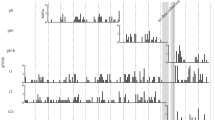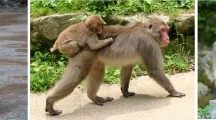Abstract
This study reports observations on juvenile female bonnet macaques (Macaca radiata) in a field cage environment. Interaction and proximity data collected on different age classes of juvenile females indicate distinct changes in social behavior from the time a female is weaned until her first pregnancy. Behavioral development includes an increase in solitary behavior, an early disinterest in younger animals, and a surprisingly low interaction rate with relatives. Important aspects of ontogeny are lost in analyses that treat all juvenile females as a single age-class.
Similar content being viewed by others
References
Altmann, J., 1974. Observational study of behavior: Sampling methods.Behaviour, 49(3–4): 227–265.
Altmann, S. A., 1968a. Sociobiology of rhesus monkeys III: The basic communication network.Behaviour, 32: 17–32.
————, 1968b. Testing Mason's hypothesis of sex differences in affective behavior.Behaviour, 32: 49–69.
Boelkins, R. C. &A. P. Wilson, 1972. Intergroup social dynamics of the Cayo Santiago rhesus with special reference to changes in group membership by males.Primates, 13: 125–140.
Burton, F. D., 1972. The integration of biology and behavior in the socialization ofMacaca sylvana of Gibralter. In:Primate Socialization,F. E. Poirier (ed.), Random House, New York, pp. 29–62.
Castellan, N. J., Jr., 1965. On the partitioning of contingency tables.Psycho. Bull., 65: 330–338.
Drickamer, L. D., 1975. Patterns of space utilization and group interactions among free-rangingMacaca mulatta.Primates, 16: 23–33.
————, 1973. Group changing in free-ranging rhesus monkeys.Primates, 14: 359–368.
Fliess, J., 1973.Statistical Methods for Rates and Proportions. John Wiley & Sons, New York.
Kimball, A. W., 1954. Shortcut formulas for the exact partitioning ofx 2 in contingency tables.Biometrics, 452–458.
Koyama, N., 1967. On dominance rank and kinship of a wild Japanese monkey troop in Arashiyama.Primates, 8: 189–216.
Lindburg, D. G., 1969. Rhesus monkeys: Mating season mobility of adult males.Science, 166: 1176–1178.
————, 1971. The rhesus monkey in North India: An ecological and behavioral study. In:Primate Behavior,L. A. Rosenblum (ed.), Academic Press, New York, pp. 1–106.
Norikoshi, K., 1971. Tests to determine the responsiveness of free-ranging Japanese macaques in food-getting situations.Primates, 12: 113–124.
Rahaman, H. &M. D. Parthasarathy, 1967. A population survey of the bonnet monkey (Macaca radiata geoffroyi) in Bangalore, South India.J. Bombay Nat. Hist. Soc., 64: 251–255.
Rosenblum, L. A., I. C. Kaufman, &A. J. Stynes, 1969. Individual distance in two species of macaque.Anim. Behavior, 12: 338–342.
Selby, S. M. 1975.Standard Mathematical Tables.S. M. Selby (ed.), CRC Press, Cleveland.
Simonds, P., 1965. The bonnet macaque in South India. In:Primate Behavior,I. DeVore (ed.), Holt, Rhinehart, & Winston, San Francisco, pp. 175–196.
Simpson, J., 1976. Social integration of MaleMacaca radiata. Unpublished doctoral dissertation.
Sugiyama, Y., 1971. Characteristics of the social life of bonnet macaques (M. radiata).Primates, 12: 247–266.
Yamada, M., 1971. Five natural troops of Japanese monkeys on Shodoshima Island: II. A comparison of social structure.Primates, 12: 125–150.
Author information
Authors and Affiliations
Additional information
This research was supported partially by US PHS Grant No. RR00169.
About this article
Cite this article
Clarke, M.R. Social interactions of juvenile female bonnet monkeys,Macaca radiata . Primates 19, 517–524 (1978). https://doi.org/10.1007/BF02373313
Received:
Accepted:
Issue Date:
DOI: https://doi.org/10.1007/BF02373313




